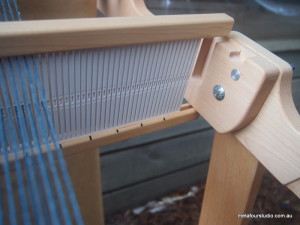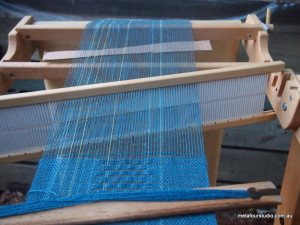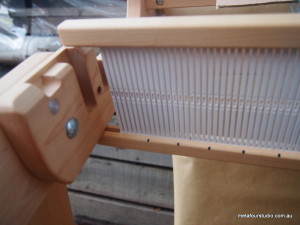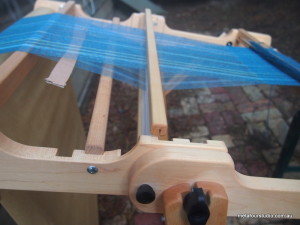A question that comes up every so often for new owners of Schacht’s Flip rigid heddle loom is how to make a down shed. It seems to depend on which version of the Flip booklet your loom came with, but it’s not always obvious how to get that shed, and few things are more frustrating when you just want to get on and weave!
Note: I use “heddle” and “reed” interchangeably here.
I’ve tried to take some good photos of the Flip’s down shed so you can see where the reed is sitting, but if there’s another angle of the loom you’d like to see, please let me know and I’ll get it for you.
 Bring the heddle toward the front of the loom, then slide the bottom rail along the curved side and base of the heddle block. Push it back so that the rail sits approximately level with the neutral slot – see left.
Bring the heddle toward the front of the loom, then slide the bottom rail along the curved side and base of the heddle block. Push it back so that the rail sits approximately level with the neutral slot – see left.
Depending on how tight your warp tension is, there might be quite a lot of resistance to pushing the reed into position – that might mean your tension is too tight.
Here’s another view, without the warp in the picture to distract.
Here’s how it looks from the side, with a nice wide shed.
Does your reed “hang” on the warp, slip forward, or otherwise not stay put under the heddle block, like this?
 There’s actually nothing wrong with this – the shed is open, the weight of the reed won’t damage your warp (unless it is unusually delicate), and you can weave just fine. But it can be annoying.
There’s actually nothing wrong with this – the shed is open, the weight of the reed won’t damage your warp (unless it is unusually delicate), and you can weave just fine. But it can be annoying.
The ‘slipping forward’ is caused by a combination of too little tension on the warp, and the angle of the loom – for example, if you are weaving with the loom in your lap and the you have the Flip propped at a sharp angle, it will tend to do this. Or, if you have the Flip on the stand and you find, as I do, that you are most comfortable weaving with the loom angled down, you may find that the reed becomes more sensitive to the tension on the warp.
I hope this is helpful! I’m happy to take more pictures for anyone who would like to see another angle.


